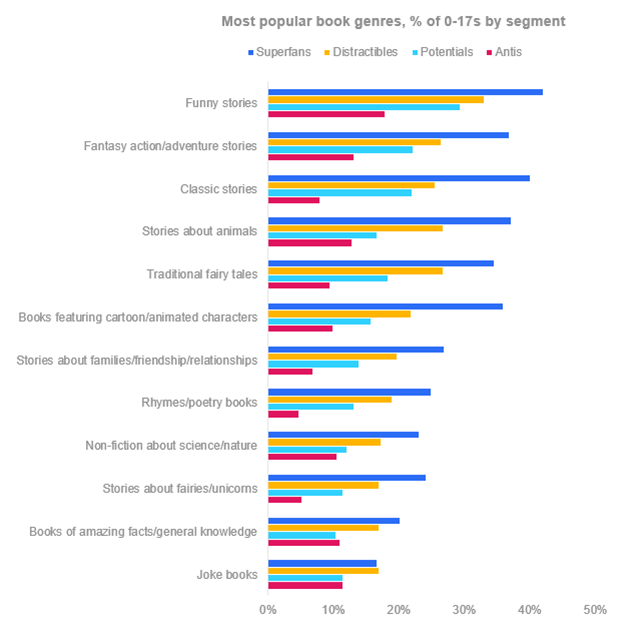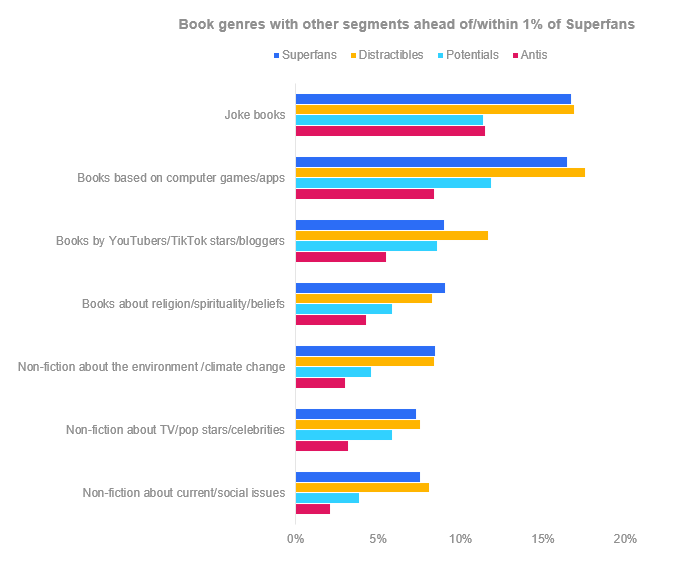Are you a ‘Superfan’ of books? If so, you have that in common with around one in five children aged 0-17 in the UK, according to the latest results from our annual Understanding the UK Children’s Book Consumer study. The study itself has been running since 2012, but since 2015, we’ve segmented 0-17s into four groups, ranging from ‘Superfans’, who are the most enthusiastic readers, to ‘Antis’, who are the least engaged with books. Sitting between those we have ‘Potentials’ and ‘Distractibles’ as the two largest groups, at 35% and 28%, respectively, for 2024, up from 28% and 24% ten years prior, which shows that children’s engagement with books is increasingly more complex than just love it or hate it.
We can look at any variables covered in the survey through the lens of the segments, whether related to books directly or to other media and leisure activities children engage in, giving insight into what else they like to do in their spare time and how and where to reach those key ‘Potentials’ and ‘Distractibles’. But we’re all about the books here at NielsenIQ BookData, so let’s dive into how genre interests vary across the four segments.
The graph below shows the top genres overall for 0-17s in 2024, with the segments separated. Funny stories are at the top of the list for all groups (although a higher share of ‘Antis’ chose ‘none: does not like books at all’, which isn’t pictured), and while fantasy action/adventure stories rank second overall and for most groups, ‘Superfans’ show a preference for classics over fantasy. Unsurprisingly, the most engaged segment has the widest interests and the highest share liking most types of books, but we do seem some genres defy that, starting with joke books at the bottom of the graph:

A slightly higher share of ‘Distractibles’ over ‘Superfans’ like joke books, which led me to look for other genres that appeal more to the other segments, or at least get within 1% of the ‘Superfans’ share. There aren’t many (only seven out of the 36 we asked about in 2024), but we can see similarities in the types of books, pictured below, with different non-fiction subjects appearing more prominent, as well as books connected to other things they may be fans of, such as games and online personalities. When asked about general preference for fiction vs non-fiction, 23% of ‘Distractibles’ and 22% of ‘Potentials’ in the latest year said they slightly or much preferred non-fiction to fiction, compared to 17% of ‘Superfans’, so while that does leave a higher share in each segment liking fiction overall, it shows that ‘Distractibles’ and ‘Potentials’ are more open to non-fiction, providing another possible outlet to grow their affinity for books.

Another key question asked in the survey is what can encourage children to read more, and more interesting books and a reading routine come out on top, both chosen by more than 20% of respondents. That varies by age and segment, with routine the top factor for ‘Superfans’ and ‘Distractibles’ and more interesting books leading for ‘Potentials’; for ‘Antis’, the highest number say that nothing would encourage them, but that’s followed by shorter books. Based on this I’d say I’m a cross between ‘Superfan’ and ‘Distractible’, a set reading time everyday sounds like a good goal!
For more insight into attitudes toward books among 0-17s and how reading fits into their lives, the Understanding the UK Children’s Book Consumer 2024 report is now available. Click here to see a preview, and for more information, please contact infobookresearch@nielseniq.com
